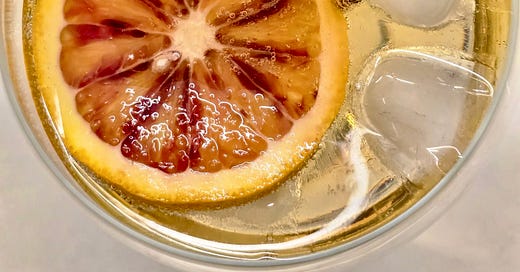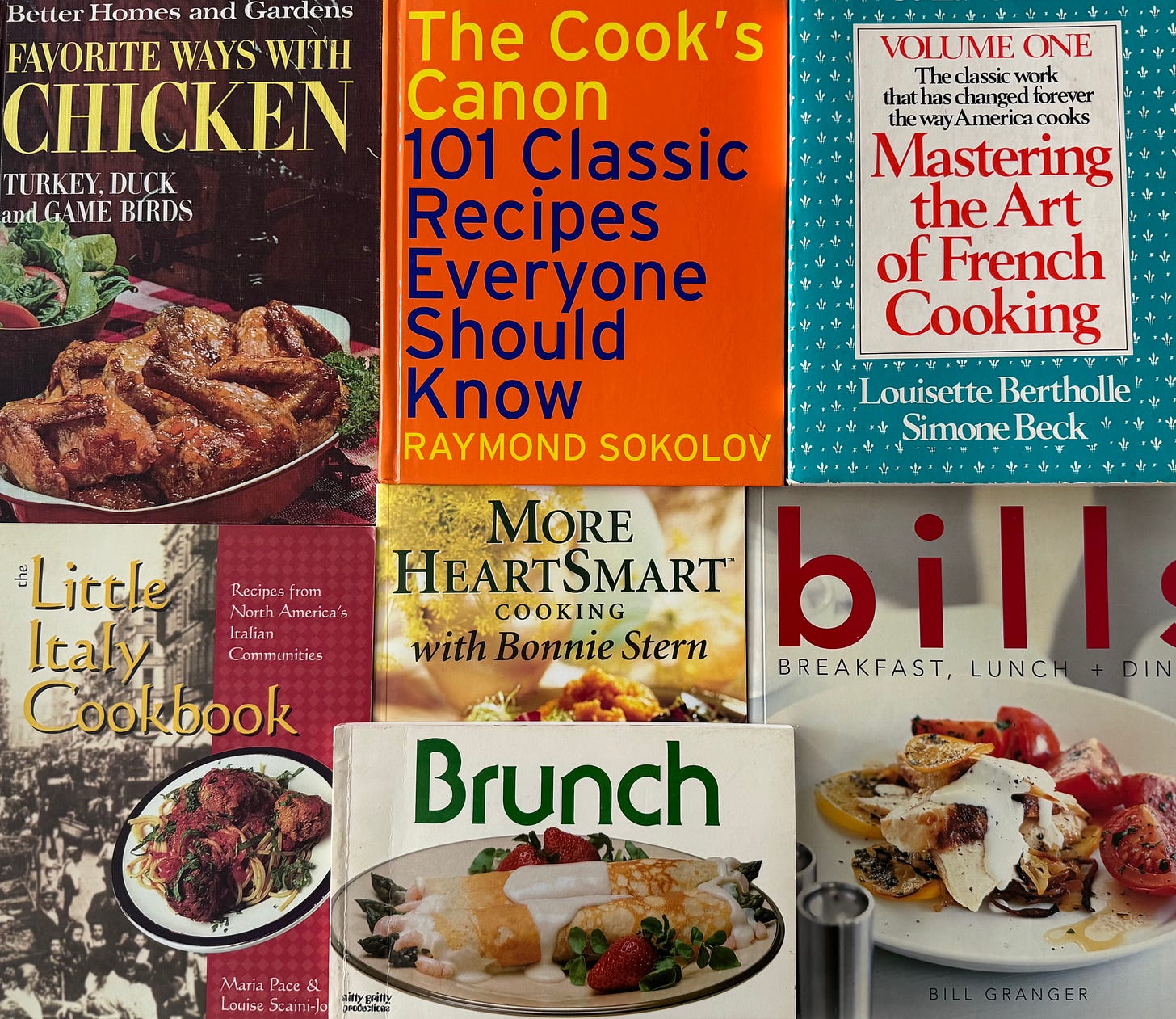At last count, I had 546 cookbooks.
Some are well-loved, recipes highlighted, my scribbled notes on variations, perhaps a smudge or two of a random ingredient. They’re the workhorses in my kitchen, the ones that I go to when I want something good that doesn’t require seeking out odd ingredients or starting three days before I want to eat.
Others are more aspirational—beautiful, evocative, filled with recipes I may never actually make but love to read. I imagine myself in those pristine kitchens, one of a brigade of chefs in white, placing the same tiny flowers on an amuse-bouche over and over again.
There’s a healthy assortment of vintage cookbooks, with browning fragile pages, tiny type, a yellowed scent of kitchens long gone. Inscrutable recipes for Jellied Chicken Bouillon, Liver Loaf with Pan Gravy, Mock Terrapin Stew, Aspic Canapés. I see the parties: bridge luncheons and buffet suppers and chafing dishes and cocktails with cigarette ashtrays artfully placed for guests and dressing up because one does for dinner.
Every book on my shelf, old or new, is a journey, a discovery, an adventure, a history lesson, and I the willing student.
The value of a cookbook
Central heating, French rubber goods and cookbooks are three amazing proofs of man's ingenuity in transforming necessity into art, and, of these, cookbooks are perhaps most lastingly delightful.
Serve It Forth, M. F. K. Fisher
In a digital world, thousands of recipes are at our fingertips—you can even find my humble contributions to the list through this newsletter. As the volume grows, I’ve seen more and more debates about the value of cookbooks or even the value of following a recipe, for that matter.
Yet when I think about what a single cookbook represents—the hours of recipe development, the artful photography, the stories behind each dish—I can’t help but think we need cookbooks more than ever before.
And why wouldn’t we? For every recipe there is a tradition of technique, of flavour pairings, of creating something that on paper doesn’t seem to make sense but somehow does: a magical combination that makes a party in your mouth.
With my library at hand, I am surrounded by friends who are wise and generous with their knowledge. As Laurie Cowin said, "No one who cooks, cooks alone. Even at her most solitary, a cook in the kitchen is surrounded by generations of cooks past, the advice and menus of cooks present, the wisdom of cookbook writers.”
How to cook a book
Back in 2009, Rich and I started a tradition. We traveled a lot for work—so much, in fact, that there were long stretches where we wouldn’t see each other for weeks at a time. It would have been easy to drift into a pattern of parallel lives, but instead, we found a way to reconnect: through food. Sunday nights, if we were both in town, we’d cook a meal together. Not just any meal—this wasn’t a casual pasta and wine situation—we’d pick a cookbook, shop for ingredients, and cook an entire meal from that book, start to finish. No substitutions, no shortcuts.
And no switching. No matter the cookbook, that random choice made it the chosen one.
And then, as life does, things shifted. By 2011, the ritual started to fade. We still cooked together, a lot (and these days I think Rich is the better cook) but the practice of choosing a book, shopping for the meal, and making an event of it slipped away.
So as we settle into our new home, learning how to navigate a different kitchen together, bringing back Sunday Dinners felt like the perfect way to kick off the year.
A way to ground ourselves, to carve out time for something meaningful, to reconnect in a way that has nothing to do with work, screens, or schedules.
And of course, it gives me a reason to dive back into those 546 cookbooks.
The beauty of this ritual is that it’s not about perfection. The beautiful crystal and fine china come out. Some meals are triumphs, others are… let’s call them learning experiences. But each Sunday dinner is a reminder of why we started this in the first place: to create something together, to enjoy the process as much as the meal, and to keep finding new ways to connect—one cookbook at a time.
If you liked this post, let me know by clicking the ❤️ button. It helps spread the word about Delicious Bits and brings me joy. Thank you, dear readers and eaters!
Apéritif Maison Baumanière
serves one
There is a wonderful Relais & Châteaux property at the foot of the ancient mountaintop village of Les Baux in Provence: Baumanière. This combination hotel, restaurant and spa feels like it has been there forever, situated as it is in the bauxite cliffs.
Back in 2014, we had a glorious New Year’s Day brunch at the fabulous restaurant. I honestly don’t know if we had the apéritif maison, and I might not have even known what it was, if it wasn’t for Simon Hopkinson’s Second Helpings of Roast Chicken, our Sunday cookbook from a few weeks ago.
But the minute we read the description of the hotel’s signature tipple in Hopkinson’s Cocktail chapter, we remembered our wonderful meal and knew that Apéritif Maison Baumanière would become our Sunday Dinner apéritif of choice.
This makes one lovely and refreshing cocktail. I’ve modified it a bit, making it slightly less boozy, but it will still give the evening a definite sparkle.
Ingredients
1 sugar cube, on which you have tapped three drops of Angostura Bitters
½ ounce Cognac
½ ounce Triple Sec or Grand Marnier
5 ounces Champagne or other good quality blanc de blanc
1 thin orange slice (blood oranges are particularly pretty)
1 chilled tulip shaped wine glass
Place the sugar cube at the bottom of the glass. Add the cognac and Triple Sec, and top with the Champagne. Add 3–4 ice cubes to the glass and float a thin slice of orange on the surface. Using a long and slender sherbet spoon, stir everything together. Serve with the spoon, so that you can to gently press the orange slice into the apéritif as you sip.








Such a wonderful tradition! I used to do the same with my son when he was undergoing intense medical treatment. He chose the cookbook & the recipe & I cooked it for him while would watch & we discussed the recipe & ingredients. Not only connected us but took our minds off the nasty stuff. Thank you, your post brought back lovely memories
What an absolutely stunning collection! That’s not just a library; it’s a treasure trove of stories, flavors, and inspiration.
As a fellow cookbook lover and collector, I’m always in awe of how these books don’t just sit on shelves but live in our minds, shape our cooking, and weave themselves into our lives like your beautiful sunday ritual of cooking together. I love how they tell stories—of places, people, and traditions—which I also try to share in my own modest way. Truly inspiring!